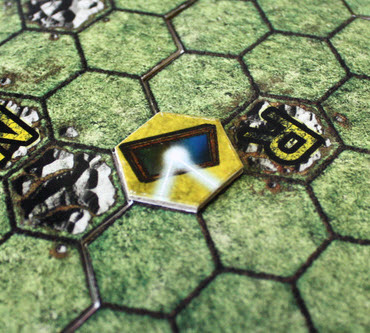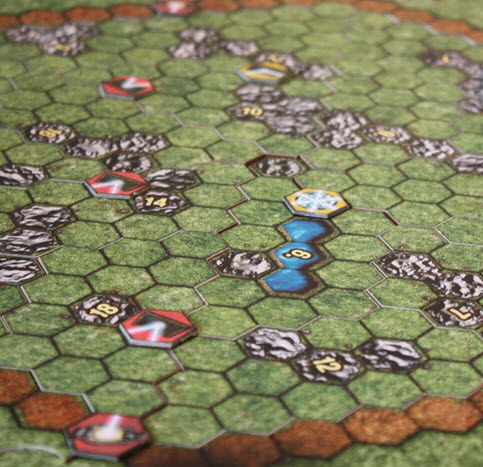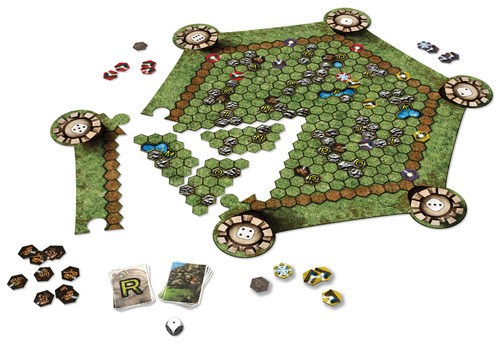You, my friend, are an intrepid troll hunter. Bless your shiny leather boots, you’re here to rid the countryside of those foul creatures and save our land from their murderous rampages – not to mention their halitosis.
So what’s your plan? You’re not just going to sit around and wait for the sun to rise, are you? Light might turn trolls to stone, but no troll with half a brain would be caught out of his cave at dawn. Oh, you have a better idea? Lanterns? Mirrors? Prisms? Go on . . .
In Troll Hunt, two to three players are out to eliminate some unwanted interlopers. Each person start out with two lanterns, five to seven mirrors, and one prism. The game board is divided into roughly three thousand hexes (Or one hundred. Or thirty. I don’t know. I’m here to kill trolls, not count tiles.) Each board is designed to be modular as to give randomness to the game and up replayability. These hexes consist of mountains, lakes, and fields. Or, as we troll hunters like to call it, nature.
First, players place their pair of lanterns around the border of the map. Directionality is very important here, so don’t just throw your lanterns down all willy-nilly and head for the tavern. If your lamp is shining in a sub-optimal direction, the only thing you’ll be catching is a troll club to the back of the skull. Ideally you’ll be shining your lantern inward, preferably toward a large open field.

Acute problems require acute solutions.
Prototype Shown
Why a field? Physics, really. The light from these lanterns can’t pass through mountain tiles, but it shines bright and steady over fields – a beacon of hope in this dark, troll-filled world. You want your light to shine for at least a few tiles so that you have an opportunity to place a mirror. Mirrors bounce the light from a lantern off in another direction.
There are two kinds of mirrors: the obtuse-angled mirror (also known as “the fat one”) reflects the beam off at a wider angle, and the acute mirror , which reflects light at a much narrower angle. Each player also has access to a prism. Prisms operate just like mirrors, only instead of reflecting the light in one direction, they refract in all directions.
Once your lanterns are placed, you now have chances to place your mirrors one-at-a-time on the board’s inner hexes. When the light from your lantern traces a straight line to one of your mirrors, it creates a Link and bounces off in whatever direction the mirror sent it. Links cannot be broken by other players’ mirrors, so you can’t plop your mirror down in the middle of someone else’s bouncing beam. What you can do, though, is utilize another player’s unfinished beams potentially to your own advantage if you play your mirrors right. Alternatively, you can adjust your own already placed mirrors by rotating, sliding, and, eventually, flipping them to suit your whims. Doing so takes time, though, so initial placement is important.
Ultimately, your goal is to shine your light into the eyes of lurking trolls, thereby turning them to stone and saving the locals. In a three-player game, the first player to transform six trolls is victorious; with two players it’s nine trolls. Once a troll is be-stoned, another troll surfaces on the map. Trolls are added to one of over 15 pre-defined locations, though the particular hex onto which they’re placed and the direction they face is determined randomly.
Troll Hunt is deceptively simple, but it caters to those with a knack for geometric acuity. “Easy to learn, difficult to master” is a classic game design truism, (although it sounds more like a 90’s TV commercial) but it applies here. The rules aren’t complicated, making it an easy to learn and fairly short game. However, Troll Hunt rewards advanced planning and requires most (if not all) of your spatial skills. Even though the trolls themselves are a bit random, Troll Hunt is not a game where you can adjust your strategy on the fly and it’s generally unforgiving of early mistakes. You have to balance the desire to spread your mirrors all over the board (giving you access to more trolls) with the desire to cluster your mirrors together (giving you more control over where your light bounces). Like many other puzzle-like games, rookie troll hunting mistakes can affect you further along in the game.
That said, the best part of the game is its difficulty. Troll Hunt comes across as a board game version of a mobile game app, except with less ads. When you finally get a troll to say “RRRGGH!” and you shine your lantern right into its dark, beady eyes, it feels like a victory. It feels worth your time and effort. Because it is. It’s one less troll in the world, and one step closer to winning. And really, who goes troll hunting because it’s easy? If you’d like to help slay this troll infestation, be sure to head on over to their Kickstarter.


